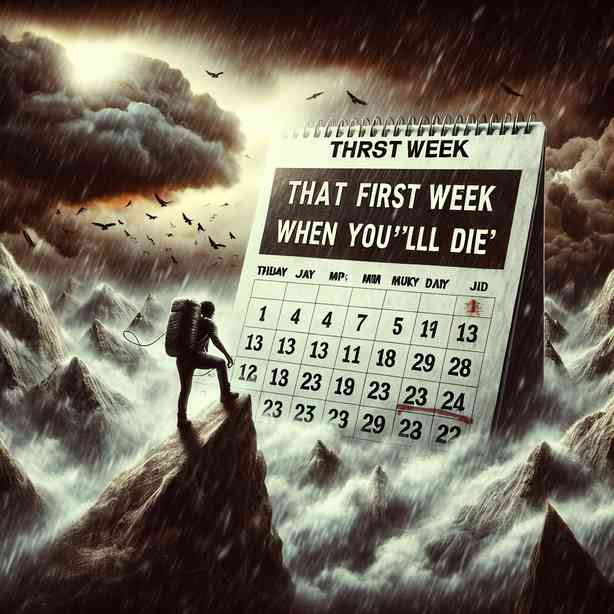
That First Week When You Think You’ll Die
When faced with a life-threatening illness or a significant health scare, individuals often recount an overwhelming sense of fear and uncertainty. It is within that first week of grappling with such a shocking diagnosis that many emotions converge. This week is often marked by intense anxiety, reflections on mortality, and the daunting reality of one’s own vulnerability. The initial reaction is often visceral; it can feel as though time comes to a standstill, enveloping the individual in a cocoon of disbelief and fear.
The psychological impact of such news cannot be underestimated. When confronted with thoughts of impending death, a person’s mind races through countless scenarios, invoking memories of loved ones, unfinished goals, and dreams yet to be realized. Questions flood the mind: What will happen to my family? Have I achieved everything I wanted in life? This barrage of thoughts creates a mental whirlwind that can lead to feelings of despair and helplessness. However, understanding that these emotions are part of the natural human response can provide a degree of comfort.
As the days progress during that first week, a stage of reflection often begins. People may reminisce about their lives, recalling both joyous and painful moments. Memories come flooding back; perhaps standing at the graduation stage, celebrating a wedding, or cradling a newborn. Each memory serves as a reminder of the beauty of life itself, rekindling a desire to fight for survival. It allows for the acknowledgment of what has been accomplished while also instilling a sense of urgency to create more memories, regardless of the uncertainty that lies ahead.
Furthermore, during this tumultuous week, one often starts searching for ways to cope. Engaging in conversations with healthcare professionals can illuminate the path forward. Understanding the specifics of one’s diagnosis and the treatment options available demystifies what can often feel like an insurmountable burden. Seeking out support groups or connecting with others who have faced similar challenges can also foster resilience. The realization that one is not alone in this journey can be incredibly powerful.
However, it is also crucial to acknowledge the complexity of emotions during this time. There may be feelings of anger, guilt, or even shame intertwined with the fear of death. Individuals may grapple with existential questions about their purpose and the impact of their lives on others. It is vital to process these feelings in a healthy manner, be it through journaling, therapy, or open discussions with trusted friends or family. Creating a safe space to explore these emotions is essential for healing.
Moreover, many people begin to reevaluate their priorities during this week. What used to seem important may shift dramatically in the face of a life-threatening situation. Relationships that were once taken for granted may come into sharper focus, prompting individuals to reach out to reconcile differences or strengthen bonds. Each interaction becomes more meaningful, reminding people of the value of connection and support. Additionally, there is often a renewed appreciation for the simple pleasures in life, such as a sunset, laughter with friends, or a moment of stillness.
An important aspect of this week is the need for self-care. Amidst the emotional turmoil, nurturing oneself can feel like a daunting task. However, practical steps can be taken to foster well-being. This may involve maintaining a balanced diet, engaging in gentle physical activity, or practicing meditation and mindfulness. Prioritizing sleep and rest are also crucial, as a well-rested mind and body are better equipped to cope with stress and anxiety. Cultivating a routine—even a simple one—can instill a sense of normality and offer a grounding effect.
As that first week progresses, many individuals may find that they begin to experience moments of hope. It is not uncommon for a flicker of optimism to emerge amidst the haze of fear. This hope may be sparked by a supportive conversation, a piece of encouraging news, or even a realization of one’s own strength. Embracing hope does not undermine the seriousness of the situation; rather, it can coexist alongside fear, creating a complex tapestry of human emotion.
Ultimately, the first week when one thinks they might die is filled with a whirlwind of emotions and thoughts. It is a critical juncture that can significantly shape one’s perspective on life. Although it can feel overwhelmingly dark, there are also opportunities for introspection, connection, and even personal growth. Each day presents a chance to reflect, reach out to loved ones, and engage with the world in a new way.
In conclusion, while the initial week following a life-threatening diagnosis is undoubtedly challenging, it can also serve as a catalyst for profound change. The blend of emotions, reflections, and realizations during this time can lead to a deeper appreciation for life and the relationships that enrich it. Although the journey ahead may be fraught with uncertainty, resilience can emerge from vulnerability, and hope can thrive alongside fear. How one navigates this period can lay the groundwork for a future filled with meaning and connection, regardless of the unknown that awaits.


